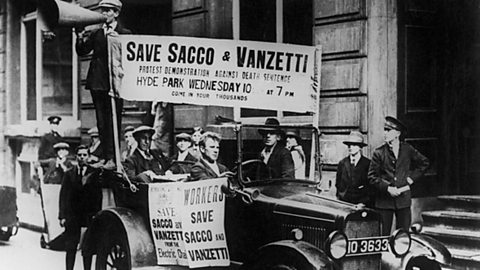The Red Scare
In the early 1920s paranoidBelieving, unreasonably, that people are against you in some way. spread about the alleged potential national threat of certain recent immigrants and radicalHaving extreme views. It was said that these people had political ideas that went against the conventional American values of democracy and capitalismAn economic system based on privately owned, as opposed to state-controlled, businesses and the creation of profit. This period was known as the Red Scare.
The development of the Red Scare
Following are the key developments of the Red Scare and the impacts they had on American fears:
- World War One - The war increased nationalistic feeling, which often created xenophobicFear or hatred of strangers or foreigners. A culture developed of perceiving immigrants as a threat.
- The Russian Revolution of 1917 - In Russia the Bolshevik political party, whose members believed in communism An economic system in which all means of production such as tools, factories and raw materials, are owned by the community as a whole. Each individual contributes according to their ability and receives according to their needs. This means there is no hierarchy of social class. successfully overthrew the government. This was followed by a civil warWhen different groups of people within the same country come into conflict with each other. between the communist Red Army and the anti-communist White Army. Some countries, including America, were concerned about the spread of communism and sent troops to support the White Army. Many feared that immigrants from Russia, Southern Europe and Eastern Europe intended to overthrow the government in America. This is why the period was known as the Red Scare.
- Labour strikes - The post-World War One economic slumpA period when the economy of a country is not doing well. made tensions between employers and trade unionA trade union is a type of organisation whose main purpose is to represent the interests of employees in a specific type of business. worse. From 1919, industrial unrest increased and several strikes occurred, including a general strikeIndustrial action that involves all or most of the main industries in a particular place (city or country). in Seattle. This industrial unrest was viewed as other example of political radicalism. It contributed to fears that radicals were plotting a revolution.
- Anarchist violence - There was a deep fear of anarchistSomeone who believes that society should be free from any government. in America as some used extreme violence as part of their politics. In 1901 President William McKinley was shot dead by an anarchist.
The Palmer Raids
The widespread fear of political radicals increased in 1919 when anarchists sent bombs to leading political figures. Several of the bombs were intercepted before they could do any harm, but some bombs did explode. In 1920, on Wall Street, New York, a bomb killed 38 people. No one was found guilty of this attack but the fear of communism and anarchism rose after the event.
The home of the US Attorney GeneralThe head lawyer of the federal government of the USA. This person is the main advisor to the president on all legal issues. A Mitchell Palmer, was bombed in July 1919. Palmer claimed that there were many communists already in America and even a few in CongressThe legislative body of the US government, made up of the Senate and the House of Representatives. In response, the government became determined to get rid of communists and anarchists in America.
A series of harsh raids against suspected political radicals and organisations led to thousands of people being arrested without trial. Hundreds of political radicals, such as the anarchist Emma Goldman, were deported. Goldman had immigrated to the USA in 1885, but her speeches and writings went against conventional American values and political ideals. She was sent back to Russia in late 1919.
The Sacco and Vanzetti case
The political paranoia created by the Palmer Raids showed intolerance and abuses of power in US democracy.
Nicola Sacco and Bartolomeo Vanzetti were Italian-born anarchists. They were charged with robbery and murder. During their trial in May 1921, the evidence presented against them was weak. Both said they were innocent and their defence team had 107 witnesses who had seen them somewhere else at the time of their alleged crime. However, Judge Webster Thayer said that although Vanzetti may not have actually committed the crime, he was "nevertheless morally culpable, because he is the enemy of our existing institutions".
Even with limited evidence, the jury found Sacco and Vanzetti guilty and sentenced them to death. There were widespread protests against the verdict, including in the UK. In 1925, another man, Celestino Madeiros, admitted to the crime. However, in 1927 Sacco and Vanzetti were given the death penalty.
